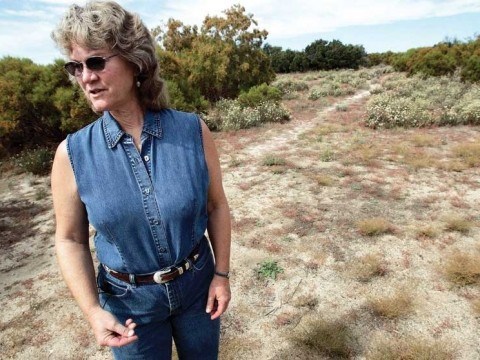High Country News
The gusty-wind warning signs on Old Highway 80 in the desert near Jacumba, Calif., aren't lying. On this rainy December day, blasts of air push Donna Tisdale's SUV all over the two-lane road which hugs the Mexican border in eastern San Diego County. Visibility is poor, but the blue-eyed, quietly intense Tisdale is unfazed. Head of the advocacy group Backcountry Against the Dump, secretary of the Protect Our Communities Foundation and chair of her rural town's planning board, she points out projects that she either helped defeat or is currently protesting - an industrial waste incinerator here, electrical substations there.
Tisdale doesn't just oppose obvious environmental nasties. She and other activists are also fighting renewable energy projects slated for the Southern California desert - a 200-megawatt wind farm in the McCain Valley, a 750 MW solar thermal array proposed for nearby Imperial County.
"Some folks call me a NIMBY," she says. "(But) I'm protecting my community. Rural towns always take the brunt of these massive industrial projects. ...We're tired of it." Besides, she adds, California cities have plenty of untapped solar potential on their own roofs.
Tisdale's a formidable opponent: just about every development she's challenged has been struck down or mired in litigation. One project, however, is just out of reach.
Tisdale points to a spine of high, rounded bluffs on the Mexico side of the border fence. "That's where it's going to be," she says: Energia Sierra Juarez, a proposed wind farm that will host hundreds of 2.5 MW turbines, each hundreds of feet tall. It's the work of Sempra, parent corporation to San Diego Gas & Electric. At full capacity, it would generate 1,250 MW of power - roughly half San Diego's average daily use - exclusively for the U.S. If permitting in Mexico goes smoothly, Sempra expects to break ground in 2011, with the first 100-125 MW phase completed in 2012.
"We're optimistic," says Sempra spokesman Art Larson. "There is an increasing demand for renewable energy in California and this is a location with tremendous wind potential."
There's likely more to it than wind quality, however. With its lower labour and land costs, hunger for economic development, shorter permitting times and protest windows, and tax incentives for renewable energy (including projects that export power), Mexico offers an attractive alternative to protracted battles with folks like Donna Tisdale. Indeed, with utilities struggling to meet California's goal of generating 20 per cent of its electricity from renewable sources this year and 33 per cent by 2030, Sempra's not the only company looking south of the border: at least three other foreign and U.S. companies have proposed exporting wind power from Baja to California.
Whether a wave of development follows, however, may depend on what happens with Energia Sierra Juarez.
Generating power in Mexico for American use isn't unprecedented. Energy giant Intergen has operated a 1,065 MW liquid natural gas (LNG) plant near Mexicali since 2003, with more than half the power exported to California. Sempra operates a 600 MW LNG plant nearby entirely for California. "It took only six months to license the plant," Sempra Energy Group chairman Don Felsinger said in 2002. "In California, it would have taken two years." Indeed, projects perceived as environmentally unfriendly or unsightly often meet fierce backlash in the state, even as its power needs grow. In 2006, local (and star-studded) opposition scuttled a proposal for an LNG terminal 14 miles off the coast of Malibu.
If it's built on schedule, Energia Sierra Juarez will be the first renewable project in Mexico to generate power for the American grid. Experts believe there could be upwards of 10,000 MW of untapped wind potential in Baja California alone. Other sites could be candidates for solar arrays. And northern Baja's ejidos - community land co-operatives, collectively owned by small groups of Mexican citizens - are clamoring for such projects.
According to its members, the 25,000-acre, 72-member Ejido Jacume, where Sempra plans to build Energia Sierra Juarez, will receive an up-front payment of $50,000 from the company, plus $10,000 yearly as long as the farm operates. The poor neighbouring border town of Jacume, Mex., population 500, won't get power, but Sempra has promised hundreds of temporary jobs and a few dozen permanent maintenance and security jobs.
Ejido member Jose Mercado rubs a gnarled hand over his stubbly cheek as he leans in the doorway of his small Jacume market. He doesn't trust Sempra, he says in Spanish, but "60 per cent of our town is working in the U.S., sending money back here. If this is successful, maybe our families can come back home and work here." Mercado is also hoping for a cut of the power profits, but no deal has been reached.
There is more land available in Mexico, and negotiating with co-operatives is easier for companies than negotiating with numerous separate landowners. A similar arrangement on private land in the U.S. would also probably be far more expensive: A single turbine can net a landowner $4,000 for every megawatt per year once electricity is flowing, and that's on top of various up-front payments.




